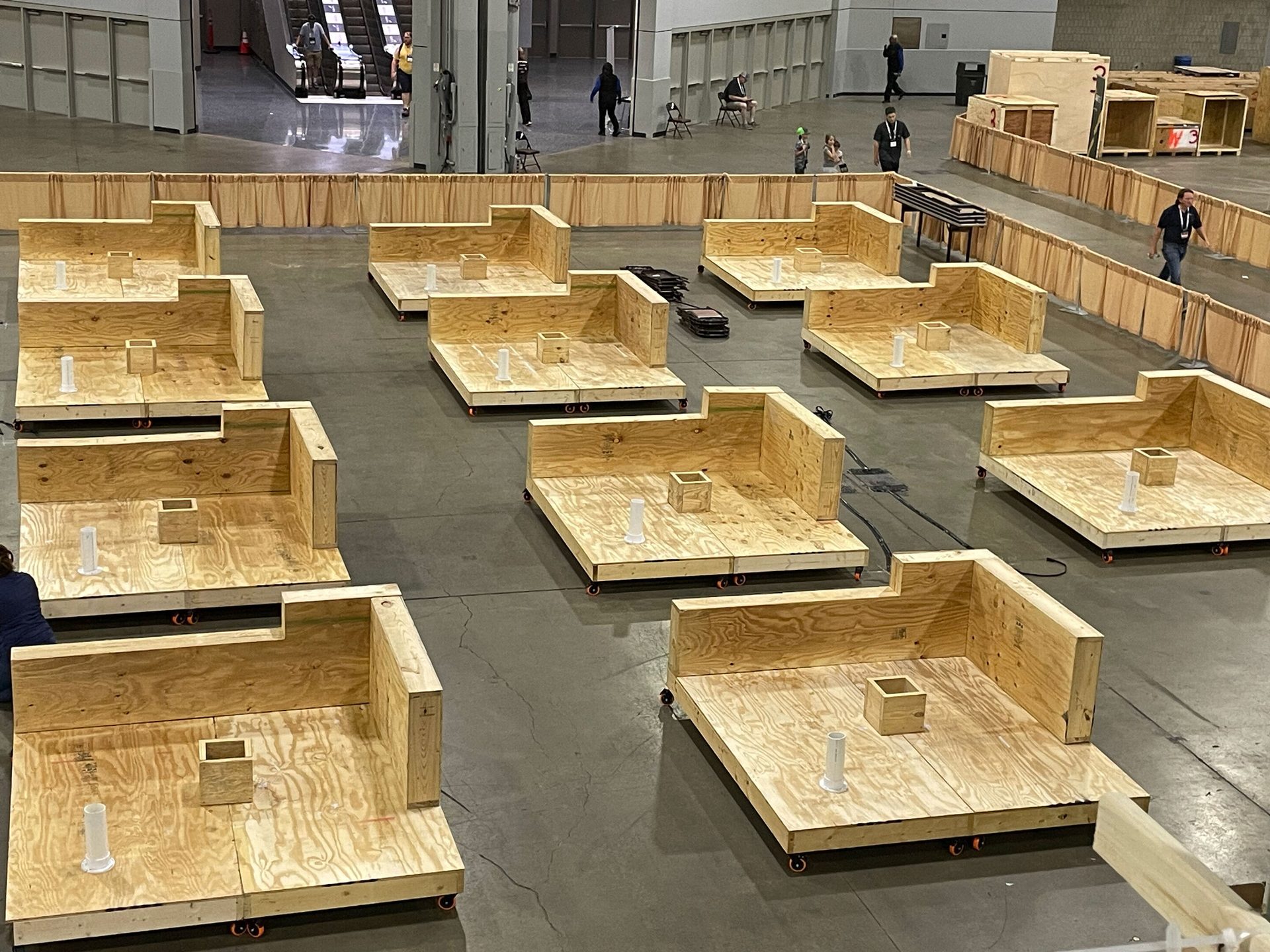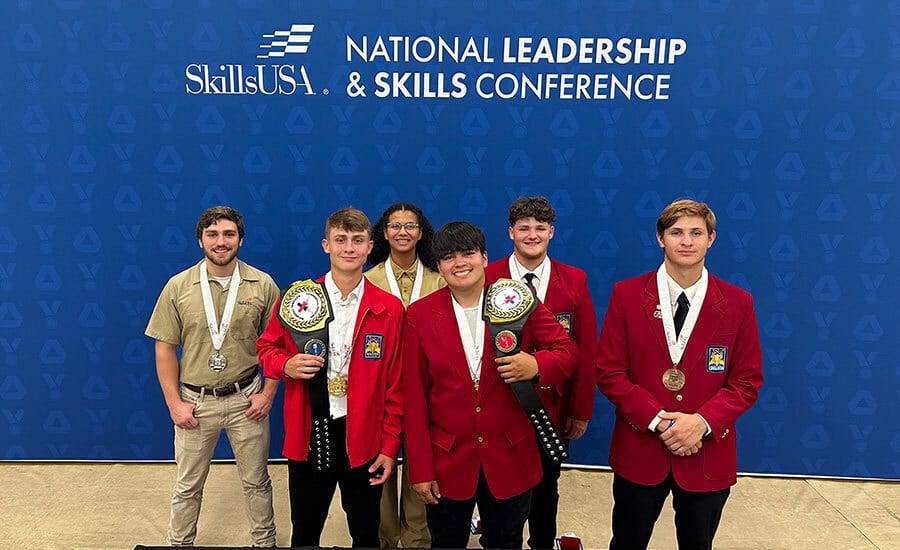Workforce Development
Photo credit: sturti/E+ via Getty Images
The commercial roofing competition took center attention in Pavilion A of the Georgia World Congress Center, where the 59th annual National Leadership & Skills Conference in Atlanta was held at the end of June. Image by Janet Cantore Watson for SkillsUSA.
Commercial Roofing Showcased at SkillsUSA
Future roofers joined more than 6,000 students nationwide at the 59th annual National Leadership & Skills Conference in Atlanta
By Bryan Gottlieb
After learning Roofing Contractor planned to cover the 59th annual National Leadership & Skills Conference in Atlanta — commonly known as SkillsUSA — last June, I admittedly had no idea what I’d be attending.
Considering the talent displayed throughout the week in practically every skilled trade, I'm embarrassed to acknowledge that oversight. From culinary arts to welding, commercial roofing to auto repair — the sheer diversity of talents on display was awe-inspiring. Virtually any occupation involving time, talent and apprenticeship was represented, with the best of the best competing for top honors.
The SkillsUSA competition represents nearly 400,000 career and technical education students and teachers nationwide in middle schools, high schools, and college or post-secondary institutions. Through the SkillsUSA Framework, students develop hands-on and career-readiness skills in more than 130 occupational areas, addressing the ongoing skills gap in the job market. Since 1965, SkillsUSA has served more than 14.6 million members. And, as obtaining a four-year college degree becomes increasingly unaffordable for many, the allure of entering a skilled trade has gained new cachet.
Being a contestant in Atlanta was a significant achievement in itself. The championships culminate a year-long process that begins in local SkillsUSA chapters across the country. Local winners advance to district or regional competitions, testing their skills against competitors from other schools. Those winners advance to state competitions each spring, and state gold medalists earn the right to compete nationally. This meant that each young person competing had already proven their worthiness to attend. Along with winning gold, silver, or bronze, competitors often earn scholarships and receive tools of the trade just by making it to nationals. Job offers are frequently presented on the competition floor.
The 2024 national event saw 115 individual trade competitions, with 6,647 high school and post-secondary students competing. SkillsUSA pegged non-participant attendance at about 10,650, including, judges, parents, spectators and the media.

A dozen workstations constructed for the commercial roofing competition mimicked a traditional low-slope roof where contestants were asked to mechanically attach a thermoplastic membrane to the deck and flash the perimeter edge wall around a box and a pipe boot. Photo by Bryan Gottlieb.
The Building Envelope and Low-Slope Commercial Roofing
This was technically the third year that low-slope roofing was part of the construction component, which now seems an oversight considering virtually every other element that comprises the building envelope participates.
This year, 11 current high school students or recent graduates joined the first day’s event, while three post-secondary entrants participated during the second day. Only four students competed in 2023.
Contestants were each presented with a mocked-up section of a low-slope roof and tasked with applying the most commonly used roof type, thermoplastic, on the same mockup used for NRCA’s ProCertification exam.
Participants put on all required safety equipment, rolled out a sheet of thermoplastic membrane, mechanically attached it to the deck, flashed the perimeter edge wall, and flashed around a box and pipe boot. The contest began the day before the hands-on skills event with a written test, like the NRCA’s TRAC: Thermoplastic course exam.
The competition emphasized the technical skills of roofing and the importance of safety and professionalism. Contestants were evaluated on their ability to perform tasks efficiently and cleanly, with points awarded for the proper teardown and removal of materials.
Contestants submitted their resumes and OSHA certifications, reflecting the competition's focus on career readiness and professional development.
That correction of omission can be attributed in large part to the Roofing Alliance, which recently donated $150,000 to help fund the roofing competition for the next three years, the National Roofing Contractors Association, which coordinated the event, and a gentleman most RC readers are well acquainted with: Rick Damato, our recently-retired editorial director.
“What impresses me the most about our roofing competitors is that most of the students here have already won a state or other competition to get to this point,” Damato explained while on the show floor. “And these young people are leaders, and they're [ambassadors] in their schools; as we begin to attract them into roofing, they'll talk to their friends about it, so I see it as growing outward from here if we can just maintain the emphasis [of] getting into the schools.”
Damato urged the industry for years to get involved with SkillsUSA because it harnesses the best up-and-coming talent in the field and, as an added value, demonstrates to the outside world the skill, concentration and qualifications necessary to become a commercial roofer.
John Esbenshade, the NRCA’s director of workforce development, was responsible for the layout and other details for the competition. He’s also helping map out how the industry will mitigate what the NRCA projects as a labor shortage of nearly 40,000 workers.
“The quality of work this year is significantly higher; I think the highest score on the written test last year would have been the lowest score on the written tests this year,” Esbenshade said.
“Now we have 11 competitors — secondary school-aged and post-secondary college-aged kids … the amount of quality of improvement that’s happened for these students and their work is inspiring and [energizes] all of us who are thinking about what we’re going to do next year.”
Esbenshade also noted that the program would be a fraction of its current size without the support of roofing suppliers.
“All the roofing materials we have on hand were made possible with the help of our distribution and manufacturing partners; SRS Distribution was a tremendous help, as was Atlas, TAMKO, Johns Manville and others,” he said.

The top winners of the commercial roofing competition, holding the “title belts,” were Tyler Hutchenson of New York (at left) and Brandon Lopez of South Carolina.
The Future of Roofing
Despite the coordination, promotion, behind-the-scenes execution and the rest, without the participants, there would be no story to tell. These young men and women are the future of skilled trades; their tenacity, backstories and grit are as admirable as the bells and whistles showcased.
At just 18 years old, Mia Pulido, who had just graduated high school, was one of two young women participating in this year’s Secondary category.
The Indiana native, attending the Skills competition for the second time, said she grew up in a “trade” family and that the competition offers a glide path toward a promising career — even if that career isn’t necessarily in commercial roofing.
“I originally tried it out [last year] just to try,” she said, explaining that the roofing competition was the only open slot available that year at her high school. “So, I was like, okay, I'll try it out, you know, and I did, and I was like, that's pretty cool.”
Matthew Rodriguez of Arizona, also 18, said that roofing is a skill he hadn’t previously given much thought to but is surprised just how much he enjoys the work — the attention to detail and opportunities the industry affords. He won third place in the Secondary competition.
“I didn't have an interest in [roofing] at first, but after a little bit, I was like, you know, it's actually kinda pretty enjoyable, kind of relaxing,” Rodriguez said. “I did carpentry last year, and I was stressed; this year, I was like, alright, I'll give it a shot, and I’m feeling pretty good. So, I know what to do and how to do it.”

Doug Duncan (left), president of Nations Roof and current chairman of the National Roofing Contractors Association, with McKay Daniels, the NRCA’s CEO, admiring the students during the competition atop the NRCA’s central scaffolding.
Moemi Marinez of Florida took second place in the Secondary category, and Brandon Lopez of South Carolina won the high school component of the competition. In the Post-Secondary category, Hunter Hamilton of Tennessee took third place, Mathew Addington of Florida took second, and Tyler Hutchenson of New York won.
Damato said he believes the NRCA sees value in how the industry can leverage SkillsUSA for recruiting and that contractors — whether members or not — have a prominent role in nurturing this vast pool of budding talent.
“If there's a contractor who happens not to be an NRCA member, we're still going to help them get into trade schools,” he said. “The ideal scenario is having a roofing contractor serve as a topic expert for those classrooms and helping them with supplying the materials and equipment they need.”
When I separate myself [from] talking about attic ventilation, I also include an explanation that the full terms of the shingle warranty are tied to balanced intake and exhaust attic ventilation. I tell them this is important because if they were to have a roof warranty issue, they could be denied for not having proper attic ventilation per the manufacturer’s installation instructions.
— Shane Gotschi
Bryan Gottlieb is managing editor of Roofing Contractor. Reach him at 248-786-1591 or gottliebb@bnpmedia.com.

